Lesson15 Soil Mechanics
- 格式:pdf
- 大小:171.36 KB
- 文档页数:4
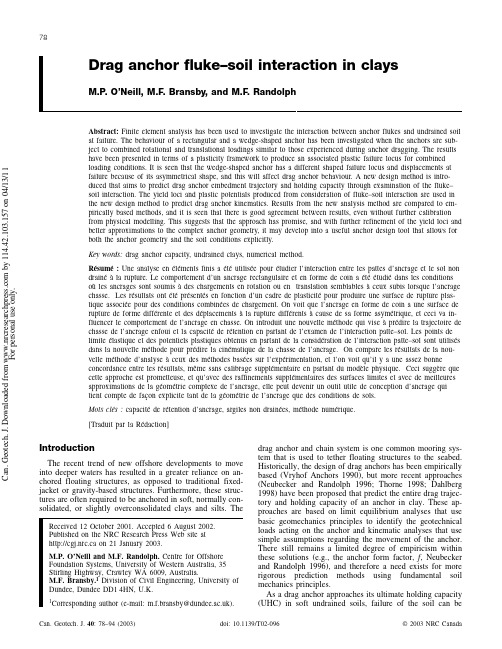
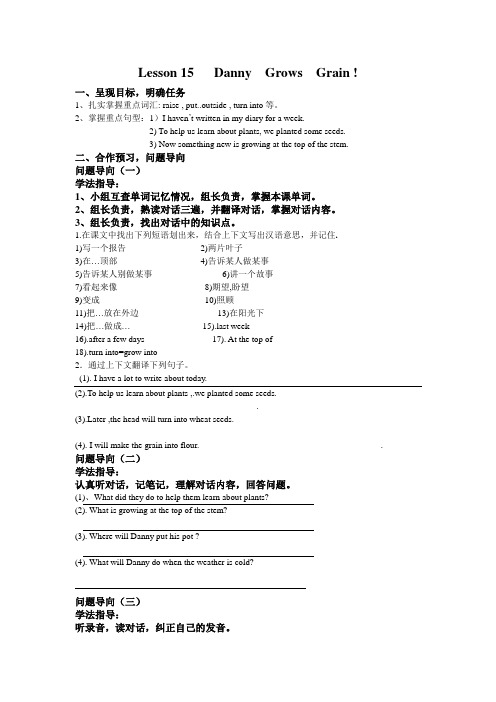
Lesson 15 Danny Grows Grain !一、呈现目标,明确任务1、扎实掌握重点词汇: raise , put..outside , turn into等。
2、掌握重点句型:1)I haven’t written in my diary for a week.2) To help us learn about plants, we planted some seeds.3) Now something new is growing at the top of the stem.二、合作预习,问题导向问题导向(一)学法指导:1、小组互查单词记忆情况,组长负责,掌握本课单词。
2、组长负责,熟读对话三遍,并翻译对话,掌握对话内容。
3、组长负责,找出对话中的知识点。
1.在课文中找出下列短语划出来,结合上下文写出汉语意思,并记住.1)写一个报告_________________2)两片叶子______________3)在…顶部__________ 4)告诉某人做某事______________5)告诉某人别做某事________________6)讲一个故事____________7)看起来像____________ 8)期望,盼望_________________9)变成__________ 10)照顾_____11)把…放在外边__________________13)在阳光下_________________14)把…做成…________________ 15).last week ________________16).after a few days _______________17). At the top of _______________18).turn into=grow into ________________2.通过上下文翻译下列句子。
(1). I have a lot to write about today.(2).To help us learn about plants ,.we planted some seeds._________________________________________ .(3).Later ,the head will turn into wheat seeds._______________________________________________________________ (4). I will make the grain into flour._________________________________________ . 问题导向(二)学法指导:认真听对话,记笔记,理解对话内容,回答问题。
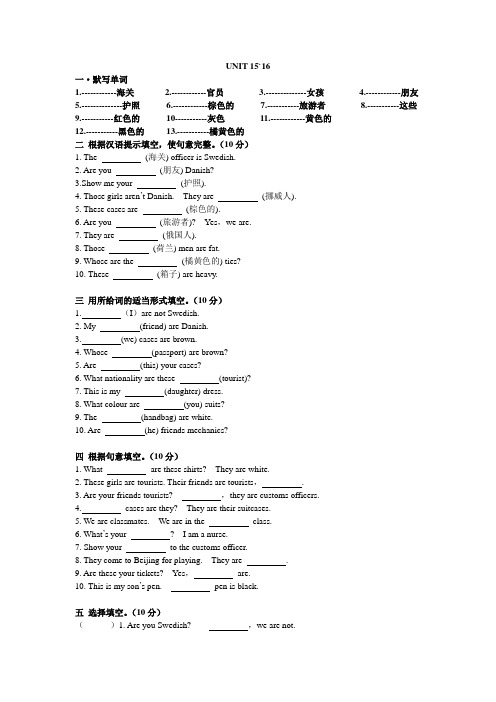
UNIT 15`16一·默写单词1.------------海关2.------------官员3.--------------女孩4.------------朋友5.--------------护照6.------------棕色的7.-----------旅游者8.-----------这些9.-----------红色的10-----------灰色11.------------黄色的12.-----------黑色的13.-----------橘黄色的二根据汉语提示填空,使句意完整。
(10分)1. The (海关) officer is Swedish.2. Are you (朋友) Danish?3.Show me your (护照).4. Those girls aren’t Danish. They are (挪威人).5. These cases are (棕色的).6. Are you (旅游者)? Yes,we are.7. They are (俄国人).8. Those (荷兰) men are fat.9. Whose are the (橘黄色的) ties?10. These (箱子) are heavy.三用所给词的适当形式填空。
(10分)1. (I)are not Swedish.2. My (friend) are Danish.3. (we) cases are brown.4. Whose (passport) are brown?5. Are (this) your cases?6. What nationality are these (tourist)?7. This is my (daughter) dress.8. What colour are (you) suits?9. The (handbag) are white.10. Are (he) friends mechanics?四根据句意填空。
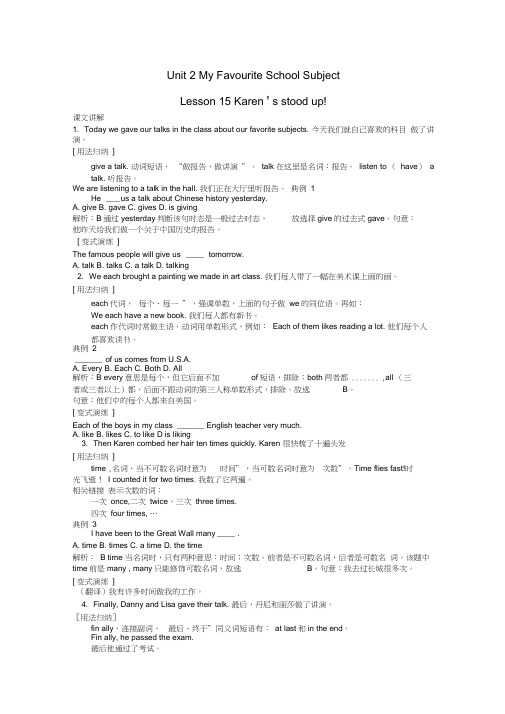
Unit 2 My Favourite School SubjectLesson 15 Karen ' s stood up!课文讲解1. Today we gave our talks in the class about our favorite subjects. 今天我们就自己喜欢的科目做了讲演。
[ 用法归纳]give a talk. 动词短语,“做报告,做讲演”。
talk 在这里是名词:报告。
listen to (have)a talk. 听报告。
We are listening to a talk in the hall. 我们正在大厅里听报告。
典例1He ___ us a talk about Chinese history yesterday.A. giveB. gaveC. givesD. is giving解析:B通过yesterday判断该句时态是一般过去时态,故选择give的过去式gave。
句意:他昨天给我们做一个关于中国历史的报告。
[ 变式演练]The famous people will give us ____ tomorrow.A. talkB. talksC. a talkD. talking2. We each brought a painting we made in art class. 我们每人带了一幅在美术课上画的画。
[ 用法归纳]each代词,每个、每一”,强调单数,上面的句子做we的同位语。
再如:We each have a new book. 我们每人都有新书。
each 作代词时常做主语,动词用单数形式,例如:Each of them likes reading a lot. 他们每个人都喜欢读书。
典例2______ of us comes from U.S.A.A. EveryB. EachC. BothD. All解析:B every意思是每个,但它后面不加of短语,排除;both两者都....... ,all (三者或三者以上)都,后面不跟动词的第三人称单数形式,排除。
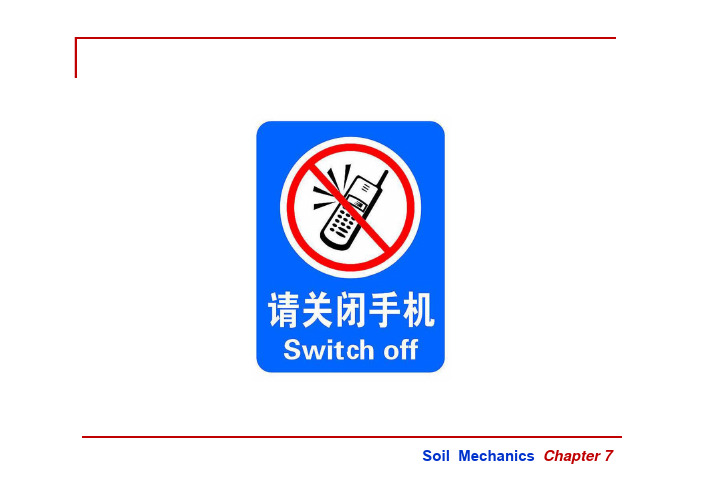
Soil Mechanics Chapter 7Chapter 0 introduction坡 定 分 概述 均质无黏性土坡 均质无黏性土坡的稳定性分析 的稳定性分析 黏性土坡的稳定性分析 土坡稳定性分析的几个问题土坡稳定性分 分分析Soil Mechanics Chapter 77.1概述 7.1 概述 述※ 土坡:是指地表一切具有侧向临空面的 土体。
它包括天然土坡和人工土坡两种。
※ 按介质分:岩质土坡、 土质土坡由于地质作用而 自然形成的土坡 在天然土体中开挖 或填筑而成的土坡 天然土坡(山坡、江河岸坡等)人工土坡 (基坑、路基、堤坝等)Soil Mechanics Chapter 7Soil Mechanics Chapter 7※ 简单土坡:土坡的顶面和底面都是水平的, 并伸至无穷远,土坡由均质土组成。
坡肩 坡顶坡高 坡底 坡脚 坡角简单土坡Soil Mechanics Chapter 7天然土坡江、河、湖、海岸坡Soil Mechanics Chapter 7山、岭、丘、岗、天然坡贵州洪家渡Soil Mechanics Chapter 7人工 边坡露天矿Soil Mechanics Chapter 7小浪底土石坝Soil Mechanics Chapter 7天生桥一级面板堆石坝Soil Mechanics Chapter 7※滑坡(Landslide ):是指土坡在一定范围内整体地沿某一滑动面向下和向外移动而丧失其稳定性的现象。
土坡的失稳往往存在外在和内在两方面的因素。
造成的因成土外在因素:剪应力的增加素坡失内在因素:土体自身抗剪强度稳的降低外界力的作用破坏了土体内原来的应力平衡状态。
如:基坑的开挖、路堤的填筑、土坡顶面上作用外荷载、土体内水的渗流、地震力的作用等。
土体内原有的应力平衡状态发生改变,超过极限状态则产生土体破坏,导致土坡坍塌。
土的抗剪强度由于受到外界因素的影响而降低,促使土坡失稳破坏。

assumption n.假定mechanics n.力学plasticity n.塑性modify v.修改,调解,变更investigate v.调查,研究manageable a.可控制【管理】的deformation n.变形incline v. (使)倾斜metal forming process 金属成型工艺【过ramp n.斜板,斜坡【道】程】slope v. (使)倾斜strain (rate) n.应变【速率】friction n.摩擦strength n.强度roll v.滚动stress n.应力multiplier n.放大器,乘法器yield stress 屈服应力broom n.扫帚flow stress 流动应力convert v.转变【化】tensile stress 拉【伸】应力handle n.手柄【把】compressive stress 压【缩】应力sweep v.扫荡【描】,掠过shear stress 剪【切】应力efficiency n.效率geometry n.几何形状gauge vt.测【计】量,校验elastic a.弹性的bearing n.轴承springback n.回弹ideal mechanical advantage 理想的机械bending n.弯曲,折弯效益precision forming 精密成型neglect vt.忽略tolerance n.公差continuum n.连续(体)metallurgical a.冶金(学)的grain n.晶粒dislocation n.位错(uni-,tri-,multi-) axial a. (单,三,多)轴(向)的anisotropy n.各向异性cylindrical a.圆柱体的cross-section n.横截面platen n. (工作)台板,模板coincide with 一致,相符validity n.正确有效,合法with ease 轻(而)易(举)的,很容易的optimization n.优化,优选(法)finite element 有限元iterative a.反复的,迭代的alternative .交替(的),可供选择的manual a.手动的,人工的trial-and-error 试凑法bias vt,n. (使)偏向【重、差】a desktop platform (计算机)桌面平台constrain(t) v,n.强制,约束response n.反【响】应,灵敏度parameter n.参数parametric a.参数的preprocess vt.预(先)加工,预处理mesh n,v.网格,啮合capability n.能力,性能,容量loop n.环,回路,循环pose v.提出model n.模型,样品displacement n.位移,排量,替换buckling n.弯【翘】曲,挠度factor n.因素gradient n.坡【梯】度,斜率flur n. 【电,磁,热,光】通量,流量multidisciplinary a.多学科的deflection n.偏移【转,离】,挠曲toughness n.韧性corrosion n.腐蚀dump v.倾倒,堆放recyle v.反复【循环】利用copper n.铜aluminum n.铝bronze n.青铜(器)alloy n.合金wear v.磨损metallic a. (含)金属(制)的specification n.操作规程,技术要求,说明书extract vt.提炼,萃取iron n.铁carbon n.碳ferrous a. (含)铁的ferrous metals 黑色金属lead n.铅zinc n.锌tin n.锡ore n.矿(石)mineral n,a.矿物(的)impurity n.杂质,不纯magnesium n.镁nickel n.镍brass n.黄铜luster n.光泽ductility n.延展性,可锻性it is likely that 很可能it is certain to (inf.)必然,一定density n.密度be distinguished from 与…区分coefficient n.系数in connection with 关于,与…相关【结合】category n.种类hardness n.硬度elasticity n.弹性beam n.横梁,一束(光)penetration n.贯穿,渗透abrasion n.磨损【耗】roll n,v.轧辊,滚,轧mill n.轧钢机,铣床spring n.弹簧permanent a.永久的rupture n.破【开】裂stamp n.冲压hammer n. (锻)锤inorganic acid 无机酸sulphuric acid 硫酸hydrochloric acid 盐酸solvent n.溶剂carbon tetrachloride 四氯化碳rigid a,n.坚硬的,刚性(的),刚度mould(mold) n.模子,塑模,铸模decoration n.装饰fabricate vt.制造【备】,生产injection molding 注射模塑(法)blow molding 吹塑(法)compression molding 压塑(法),模压(法)extrusion n.挤压vacuum forming 真空模塑(法)powder metallurgy 粉末冶金constituent n,a.组成【的,部分】,组元simultaneously adv.同时subsequently adv.随后coherent a.互相凝聚的,协调一致的fusion n.熔化,熔接crystalline n,a.结晶【的】,晶体【的】restriction n.限制【定】,节流blend n,v.混合【物】,融合press n,v.压力机,压制homogeneous a.均匀的sinter n,vt.烧结【物】die n.模具,锻【冲】模,凹模die life 模具寿命die failure 模具损坏deterioration n.变坏,退化,损耗surface finish 表面光洁度breakdown n.破坏,击穿lubrication n.润滑cracking n.裂纹breakage n.断裂mode n.方式,状态,模式thermal fatigue 热疲劳layer n.层abrasive n,a. (研) 磨料 (的),磨损 (的)impression n.模膛,型腔(槽)heat checking 热裂纹,龟裂steep n,a.陡(坡)的,急剧的reversal n.颠倒,相反overload n,v. (使)过【超】载initiation n.开【初】始,发【产】生discrete a.不连续的,单个的variable n.变量cavity n.模膛,型槽stock n.坯料,原材料impact n,v.冲击,碰撞cold[hot] working 冷热加工forging n.锻造,锻件classification n.分类recrystallization n.再结晶take place 发生strain [deformation] hardening 应变【变形】硬化be referred to as 叫做,称为,被认为是warm working 温加工,温锻ultimate a,n.最终的,首要的,极限stress relieving 消除应力处理austenitic a.奥氏体的stainless steel 不锈钢annealing n.退火grain size 晶粒度solid solution 固溶体refinement n.精炼【制】,细化hazard n.危险,未知数,意外事件inherent a.固有的,先天的,本质的sensitive a.灵敏的,敏感的abnormal a.非正常的critical strain 临界应变casting n.铸造【件】die-casting n.模铸【件】foundry n.铸造【车间】pour v.浇注suitability n.适应性pig iron 生铁cupola n.冲天炉,化铁炉erosion n.腐蚀, (侵、烧)蚀ladle n.铁水包graphite n.石墨solidify v. (使)凝固disjoin v.拆散,分开ingot n. (钢)锭destructive a.破坏(性)的,有害的retard vt,n. (使)延缓,推迟solvent n,a.溶剂(的)copper-base alloy 铜基合金machine-building 机械制造plastic working 塑性加工billet n 坯料,锻坯blank n.坯料, (冲压)板坯configuration n.外形,配置,排布stroke n.行程,冲程amortize v.阻尼,缓冲,分期偿还reliability n. 可靠性,安全性drawing n. (锻坯)拔长,【线,管材】拉拔deep drawing 深冲(压)brake forming 【压】折弯(机)成型stretch forming 张拉成型military n,a.军队【事,人】 (的)consumer goods 消费品integrity n.完整性,完全(善)jet engine 喷气发动机turbine n.涡【汽】轮(机),透平(机)regarding 考虑到,关于armor n.铠甲immortalize vt. (使)不朽(灭)blacksmith n.锻工mechanical press 机械压力机hydranlic press 液压机anvil n. (锤)砧,砧座craftsman n.技工handling n.处理,装卸,搬运flexibility n.柔(韧)性,灵活性drawn out 拔长upset n.镦粗,顶锻closed impression die 闭式模锻rapid-impact blow 快速冲击,猛打vertical a.立式的ram n.锤头,滑块,活动横梁block n. (模)块draft n.模锻斜度symmetrical a.轴对称的sizing n.整形,校正,定径drop forging 落锻,锤模锻impression die forging 模锻final forging 终锻overheat n.过热furnace n. 【熔,高】炉pyrometer n.高温计metalworking n.金属压力加工knead v.揉搓【制】refine v.精炼【制】,细化porosity n.多孔性,疏松orient v. (使)定【取】向flow line 流线stress field 应力场manual skill 手工技巧at one’s command 自由使用,支配soundness n.致密性,坚固性,无缺陷attainable a.可达【得】到的open die forging 自由锻gross n.总共,重大confine vt. 限制,约束convert v.转变【换】,更换broken up 破【断】裂,分散microshrinkage n.显微缩孔elimination n.消除,淘汰align v.调整,对中,校直weld(ing) v,n.焊接,熔焊pressurewelding 压力焊spotwelding 点焊buttwelding 对头(缝)焊fusionwelding 熔焊,熔接fiux-shielded arc welding 熔剂保护电弧焊diversity n.不同多样性fasten(ing) v,n.连接(件),紧固(件)shielding n.遮护,屏蔽solder(ing) v,n.软钎焊, (低温)焊料bismuth n.铋cadmium n.镉rivet n,v. 铆钉,铆接braze n,vt.硬钎焊,铜焊oxidation n.氧化flux n.焊接,助溶剂squeeze v.挤压oxy-acetylene n,a.氧(乙)炔(的) torch n.焊炬electrode n.电(焊)极,焊条filler n.填充(剂)overlap v.搭接,重叠strike v.攻【打】击,放电heat treatment 热处理microstructure n.显微组织low-carbon steel 低碳钢prescribe v.规定,指示microscopic a.显微的,微观的spheroidizing n.球化(处理) normalizing n.正火, (正)常化annealing n.退火hardening n.淬火tempering n.回火soaking(=holding) n.均热,保温retarding media 延缓介质prolonged a.长时间的,持续很久的critical temperature 临界温度globular a.球形(状)的carbide n.碳化物,硬质合金quenching n.淬火,骤冷removal n.除去,放出mechanism n.机械,机构,机构学kinematic a.=kinematical 运动的,运动学的kinematic chain 运动链link n.构件,杆件. v.连接【结】definite a.确定的constrained a.约束的,限定的unconstrained a.无约束的linkage n.连杆(组,机构)joint n.结【接】台,铰链 . a.连接的,联合的pin n.销【钉】,铰销revolution v.旋转,转动. n.回转体prismatic a.棱柱(形)的nonlinear a.非线性的four-bar linkage 四杆机构kinematic chain 运动链prime mover 原动者【机】,驱动件coupler n.连接件,连杆pivot n.枢(轴),轴销,回转副,旋转中心configuration n.外形,构造,结构inversion n.转换,更换slider-crank mechanism 曲柄滑块机构multiloop n.多环链, a.多回路的sketch n.草【简,示意】图, v.画草图,草拟skeleton diagram 草图,示意图,简图envision v.想象binary a.二【双,复】的,二元的ternary a.三元的ternary links 三杆组quaternary a.四元的quaternary links 四杆组cam 凸轮cam follower n.凸轮从动件gear n.齿轮sprocket n.链轮belt n. 【皮,布,钢】带pulley n.带轮spherical a.球的,球面的helical a.螺旋的three-dimensional 三维的,空间的intuitively adv.直觉【观】地synthesis n.合成(法),综合kinematician n.运动学研究者(家) innate a.先天的,固有的criterion n. (判断)标准,判据,准则branch n,v.分(部,支)transmission angle 传动角rock n.摆动, v.摇动oscillate v.摆动,摇动parallelogram n.平行四边形antiparallelogram n.反平行四边形frame n.机架,构架impart v.给予,分给to impart M to N 把 M 给 Ntorque n.力矩,扭矩dynamic a.=dynamical 动力的,动力学的inertia n.惯性(物),惯量static a.=statical 静力【学】的,静的index n.指数,指标friction n.摩擦thumb n.拇指, v.用拇指翻rule of thumb 根据经验和实际所得的做法matrix n.矩阵determinant n.行列式derivative n.导数derivative of M with respect to N M对于 N 的导数movability n.可动性,易动性parameter n.参数discount v.打折扣,忽视absolute a.绝对的graphical a.图形的,图解的polygon n.多边形theorem n.定理stress n.应力bearing n.轴承centripetal a.向心的packaging machinery 包装机械lubrication n.润滑specification n.技术要求actuation n.驱动jerk n.震动,冲击axis n.轴【线,心】,中心线contour n.外形,轮廓线eccentricity n.偏心【度,率】gear ration 齿轮【速,齿数】比topologically adv.拓扑学地customary a.通常的,习惯的correlate v.使相关,使发生关系analog n.=analogue 类似(物),模拟linear analog 线性模拟second acceleration 二阶加速度higher acceleration 高阶加速度paraphrase v.释义,意译describe v.叙述,描述,作…运动category n.种类,类别deliberation n.慎重考虑province n.省,领域preconceive v.预想,事先想好analog computer 模拟计算机trace v.追踪,描画timing n.定时,计时,配时pitch v.投掷trajectory n.轨迹embed v.嵌入,夹在层间orientation n. (定)方位, (取)方向scoop n.勺子,铲斗, v.挖,掘,铲cam n.凸轮gear n.齿轮curve n.曲线 a.弯曲的groove n.槽,沟mate v.配合,啮合cylindrical a.圆柱的two-dimensional or planer 两维的或平面的three-dimensional or spatial 三维的或空间的normal n.法线 a.垂直的complement n,a.余角,余的collinear a.共线的lateral a.横向的,侧向的stem n.杆guide n.导向件【器,装置】,导槽(座)intermittent a.间断的,不连续的dwell n,v.停止,小停顿inertial a.惯性的,惯量的engage v.啮合rack n.齿条noncircular a.非圆的conjugate a.共轭的, n.共轭值(线)cycloidal a.摆线的involved a.渐开线的, n.渐开线tolerance n.间隙,公差spur gear 直齿圆柱轮radial a.径向的,沿半径的offset n,vt.偏移,偏心 a.偏心的disk cam 盘形凸轮tangent n.切线 a.相切的,切线的concentric a.同圆(的),同心(的)camshaft n.凸轮轴pitch curve 节线herringbone a.人字形的intersect v.横穿,相交parallel helical gear 斜齿轮,平行轴螺旋齿轮crossed helical gear 交错轴螺旋齿轮face gear 端面齿轮spiral bevel gear 螺旋齿圆锥齿轮worm n.蜗杆skew bevel 斜齿圆锥齿轮hypoid gear 准双曲面(直角交错轴双曲面)齿轮addendum n.齿顶,齿顶高project v.伸出,突出clearance n.间隙dedendum (pl. dedenda)n.齿根,齿根高tooth space 齿间距backlash n.间隙,齿隙screw n.螺钉,螺丝, v.旋紧,攻丝fastener n.紧固件joint n.连【联】接,接合bolt n.螺栓nut n.螺母cap screw 有头螺钉setscrew n.定位【固定,调整】螺钉rivet n.铆钉, v.用铆钉铆接key n.键weld n,v.焊接,熔焊braze n,v.钎焊,铜焊clip n.夹子, v.夹住,夹紧synonymous a.同意义的monotonous a.单调的taint n.污点,污染 v.弄脏tough a.坚韧的ductile a.可延伸的,有延展性的,韧性的tighten v.上紧,拉紧twist v.扭转jumbo n.大型喷气式客机titanium n.钛close-tolerance 高精密度的tooling n.工具,刀具 v.用刀具(切削)加工proliferate v.增殖,增殖assembly n.安装,装配,组件tap n.丝锥, v.攻螺丝stud n.双头螺栓resemble v.类似,像thread n.螺纹(线),v.车螺纹drill n,v.钻孔hexagon head 六角头fillister n.凹槽flat head 平头hexagon socket head 六角沉头disassemble v.拆开tensile a.拉【张】力的,受拉的shear n.剪切【力】 v.剪切【断】harden v.使硬【化】washer n.垫圈preload n.预载荷fatigue n.疲劳micrometer n.千分尺,千分表elongation n.拉【伸】长modulus n.模数,模量wrench n.扳手dial n.刻度盘fractional a.分数的,小数的helical gear 斜齿轮worm n.蜗杆,螺杆bevel gear 圆锥齿轮helix n,a. (pl. helices 或 helixes)螺旋线,螺旋线的right hand 右手,右旋的helicoid .螺旋【面,体】,螺旋(状,纹)的wrap v.缠绕unwind v.解开,展开generate v.产生,展成(加工)engagement n.啮合,接触diagonal n,a.对角线(的)objectionable a.该反对的,不能采用的spiral n,a. 螺旋线(的),卷线(的)spiral gear 螺旋齿轮mesh n.啮合worm gear 蜗轮pinion n.小齿轮pitch cylinder 节圆柱concave a.中凹的curvature a.曲率screw-like 像螺丝(杆)的thread n.线状物,螺纹线envelop v.包围,封闭enclose v.包围lead angle 导角cast v.铸造mill v.铣削outboard a,ad.外侧的,向外pronounced a.明确的,显著的stress n.应力tapered a.锥形的positively ad.确定地,强制(传动)地Pitch-line velocity 节线速度automobile differential 汽车差速器gearing n.齿轮传动(装置)offset n.偏置,横距hypoid a.准双曲面的hyperboloid n.双曲面,双曲面体shaft n.轴clutch n.离合器brake n.制动器pulley n. (皮,胶)带轮flywheel n.飞轮sprocket n.链轮,星轮bending moment 弯曲力矩torsional a.扭转的static a.静(力,态)的axle n.心轴,轮轴spindle n.心轴,主轴deflection n.偏移,弯曲fillet n.圆角,倒角peening n.喷射(加工硬化法)shot peening 喷丸硬化stiff a.刚性的inertia n.惯性,惯量slippage n.滑动actuation n.驱动,开动coefficient n.系数statics n.静力学rim n.边缘,轮缘shoe n.闸瓦,制动片【块】band n.带,条cone n.圆锥miscellaneous a. (混)合的,杂项的assume v.假设,承担statical a.=static,静态的equilibrium n.平衡reaction n.反应,反力overload-release clutch 超载释放(保护)离合器magnetic fluid clutch 磁液离合器shift v.变换, (使)移动lever n.杆, (手)柄jaw n.颚板,夹爪ratchet n.棘轮circumferentiallyad v.周围地,圆周地mate v.配合,啮合,联接synchronous a.同步的linear drive 线性驱动装置clicking n. ‘卡塔’声freewheel v.空转coupling n.联轴器sleeve n.套筒flat n.平面(部分) a.平的periphery n.圆周,周边wedge n.楔(形物) v.楔入pawl n.棘爪powder n.粉末mixture n.混合物electromagnetic a.电磁的coil n.线圈excitation n.刺激,激励shearing a.剪切的lockup n.锁住manipulator n.操作器,控制器,机械手peripheral a.周围的,外围的idiot n.白痴integrate v.使成为一体,使结合起来hard automation 刚性自动化a host of 许多execute v.执行binary a.二进制的read only memory (ROM) 只读存储器random access memory (RAM)读写存储器,随机存储器erasable a.可擦去的volatile a.可丢失的harsh a.恶劣的robust a.稳定的configuration n.结构,组态Morse Code 莫尔斯电码suffice v.足够interference n.干扰fluctuation n.脉动,波动expendable a.可消耗的intermediate a.中间的adaptor n.转换器transformer n.变压器rectifier n.整流器capacitor n.电容器Zener diode 齐纳(稳压)二极管buffer n.缓冲寄存器come across 碰到Baud rate 波特率albeit conj.虽然light-emitting diodes 发光二极管relay ladder logic 继电器梯形逻辑图archaically a.古体的,旧式的retention n.保留,保持versed a.熟练的,精通的fluidics n.射流sheer a.完全的,绝对的profligate a.浪费的proprietary a.专利的,专有的boolean expression 布尔表达式Computed-aided design(CAD) n.计算机辅助设计Computed-aided manufacturing(CAM) n.计算机辅助制造automatic factory n.自动化工厂drafting n.制图Computer-aided engineering n.计算机辅助工程management information systems n.管理信息系统graphics terminal n.图像终端a shared data base n.公用数据库three-dimensional a.三维的keyboard n.键盘lightpen=light pen n.光笔magnify v.放大flip v,n.翻转copy v.拷贝a mirror image 镜像symmetrical a.对称的artwork n.印刷线路原图Geometric modeling n.几何模型制造kinematics n.运动学fexible manufacturing systems(FMS)柔性制造系统flexible manufacturing celles(FMC) 柔性制造单元automated guided vehicles 自动搬运小车conveyor n.传送装置pallet loading and unloading carts 上下料小车part program 零件程序data base 数据库data processing networks 数据处理网络inspection program 检测程序robot program 自动机程序real-time control data 实时控制数据the Control hierarchy 控制层次real-time fault recovery 实时故障恢复unmanned operation 无人化操作chip removel 排屑module n.模块,组件intelligent node 智能节点。
SOIL MECHANICSLECTURE NOTESLECTURE # 1SOIL AND SOIL ENGINEERING* The term Soil has various meanings, depending upon the general field in which it is being considered.*To a Pedologist ... Soil is the substance existing on the earth's surface, which grows and develops plant life.*To a Geologist ..... Soil is the material in the relative thin surface zone within which roots occur, and all the rest of the crust is grouped under the term ROCK irrespective of its hardness.*To an Engineer .... Soil is the un-aggregated or un-cemented deposits of mineral and/or organic particles or fragments covering large portion of the earth's crust.* Soil Mechanics is one of the youngest disciplines of Civil Engineering involving the study of soil, its behavior and application as an engineering material.*According to Terzaghi (1948): "Soil Mechanics is the application of laws of mechanics and hydraulics to engineering problems dealing with sediments and other unconsolidated accumulations of solid particles produced by the mechanical and chemical disintegration of rocks regardless of whether or not they contain an admixture of organic constituent."* Geotechnical Engineering ..... Is a broader term for Soil Mechanics.* Geotechnical Engineering contains:- Soil Mechanics (Soil Properties and Behavior)- Soil Dynamics (Dynamic Properties of Soils, Earthquake Engineering, Machine Foundation)- Foundation Engineering (Deep & Shallow Foundation)- Pavement Engineering (Flexible & Rigid Pavement)- Rock Mechanics (Rock Stability and Tunneling)- Geosynthetics (Soil Improvement)Soil Formation* Soil material is the product of rock* The geological process that produce soil isWEATHERING (Chemical and Physical).* Variation in Particle size and shape depends on:- Weathering Process- Transportation Process* Variation in Soil Structure Depends on:- Soil Minerals- Deposition Process* Transportation and DepositionFour forces are usually cause the transportation and deposition of soils1- Water ----- Alluvial Soil 1- Fluvial2- Estuarine3- Lacustrine4- Coastal5- Marine2- Ice ---------- Glacial Soils 1- Hard Pan2- Terminal Moraine3- Esker4- Kettles3- Wind -------- Aeolin Soils 1- Sand Dunes2- Loess4- Gravity ----- Colluvial Soil 1- TalusWhat type of soils are usually produced by the different weathering & transportation process?- Boulders- Gravel Cohesionless- Sand (Physical)- Silt Cohesive- Clay (Chemical)* These soils can be- Dry- Saturated - Fully- Partially* Also they have different shapes and texturesLECTURE # 2SOIL PROPERTIESPHYSICAL AND INDEX PROPERTIES1- Soil Composition- Solids- Water-Air2- Soil Phases- Dry- Saturated * Fully Saturated* Partially Saturated- Submerged3- Analytical Representation of Soil:For the purpose of defining the physical and index properties of soil it is more convenient to represent the soil skeleton by a block diagram or phase diagram. 4- Weight - Volume Relationships:WeightW t = W w + W sVolumeV t = V v + V s = V a + V w + V s 1- Unit Weight - Density* Also known as- Bulk Density- Soil Density-Unit Weight-Wet DensityRelationships Between Basic Properties:Examples:________________________________________________________________________Index PropertiesRefers to those properties of a soil that indicate the type and conditions of the soil, and provide a relationship to structural properties such as strength, compressibility, per meability, swelling potential, etc.________________________________________________________________________1- PARTICLE SIZE DISTRIBUTION* It is a screening process in which coarse fractions of soil are separated by means of series of sieves.* Particle sizes larger than 0.074 mm (U.S. No. 200 sieve) are usually analyzed by means of sieving. Soil materials finer than 0.074 mm (-200 material) are analyzed by means of sedimentation of soil particles by gravity (hydrometer analysis).1-1 MECHANICAL METHODU.S. Standard Sieve:Sieve No. 4 10 20 40 60 100 140 200 -200Opening in mm 4.76 2.00 0.84 0.42 0.25 0.149 0.105 0.074 -Cumulative Curve:* A linear scale is not convenient to use to size all the soil particles (opening from 200 mm to 0.002 mm).* Logarithmic Scale is usually used to draw the relationship between the % Passing and the Particle size.Example:Parameters Obtained From Grain Size Distribution Curve:1- Uniformity Coefficient C u (measure of the particle size range)Cu is also called Hazen CoefficientCu = D60/D10C u < 5 ----- Very UniformC u = 5 ----- Medium UniformC u > 5 ----- Nonuniform2- Coefficient of Gradation or Coefficient of Curvature C g(measure of the shape of the particle size curve)C g = (D30)2/ D60 x D10C g from 1 to 3 ------- well graded3- Coefficient of Permeabilityk = C k (D10)2 m/secConsistency Limits or Atterberg Limits:- State of Consistency of cohesive soil1- Determination of Liquid Limit:2- Determination of Plastic Limit:3- Determination of Plasticity IndexP.I. = L.L. - P.L. 4- Determination of Shrinkage Limit5- Liquidity Index:6- Activity:SOIL CLASSIFICATION SYSTEMS* Why do we need to classify soils ?To describe various soil types encountered in the nature in a systematic way and gathering soils that have distinct physical properties in groups and units.* General Requirements of a soil Classification System:1- Based on a scientific method2- Simple3- Permit classification by visual and manual tests.4- Describe certain engineering properties5- Should be accepted to all engineers* Various Soil Classification Systems:1- Geologic Soil Classification System2- Agronomic Soil Classification System3- Textural Soil Classification System (USDA)4-American Association of State Highway Transportation Officials System (AASHTO) 5- Unified Soil Classification System (USCS)6- American Society for Testing and Materials System (ASTM)7- Federal Aviation Agency System (FAA)8- Others1- Unified Soil Classification (USC) System:The main Groups:G = GravelS = Sand.........................M = SiltC = Clay........................O = Organic........................* For Cohesionless Soil (Gravel and Sand), the soil can be Poorly Graded or Well GradedPoorly Graded = PWell Graded = W* For Cohesive Soil (Silt & Clay), the soil can be Low Plastic or High Plastic Low Plastic = LHigh Plastic = HTherefore, we can have several combinations of soils such as:GW = Well Graded GravelGP = Poorly Graded GravelGM = Silty GravelGC = Clayey GravelPassing Sieve # 4SW = Well Graded SandSP = Poorly Graded SandSM = Silty SandSC = Clayey SandPassing Sieve # 200ML = Low Plastic SiltCL = Low Plastic ClayMH = High Plastic SiltCH = High Plastic ClayTo conclud if the soil is low plastic or high plastic use Gassagrande's Chart________________________________________________________________________ 2- American Association of State Highway Transportation Officials System (AASHTO):- Soils are classified into 7 major groups A-1 to A-7Granular A-1 {A-1-a - A-1-b}(Gravel & Sand) A-2 {A-2-4 - A-2-5 - A-2-6 - A-2-6}A-3More than 35% pass # 200A-4Fine A-5(Silt & Clay) A-6A-7Group Index:_________________________________________________ ___3- Textural Soil Classification System (USDA)* USDA considers only:SandSiltClayNo. Gravel in the System* If you encounter gravel in the soil ------- Subtract the % of gravel from the 100%.* 12 Subgroups in the systemExample: ********MOISTURE DENSITY RELATIONSHIPS(SOIL COMPACTION)INTRODUCTION:* In the construction of highway embankments, earth dams, and many other engineering projects, loose soils must be compacted to increase their unit weight.* Compaction improves characteristics of soils:1- Increases Strength2- Decreases permeability3- Reduces settlement of foundation4- Increases slope stability of embankments* Soil Compaction can be achieved either by static or dynamic loading:1- Smooth-wheel rollers2- Sheepfoot rollers3- Rubber-tired rollers4- Vibratory Rollers5- Vibroflotation_____________________________________________________________________________________________General Principles:* The degree of compaction of soil is measured by its unit weight, , and optimum moisture content, w c.* The process of soil compaction is simply expelling the air from the voids.or reducing air voids* Reducing the water from the voids means consolidation.Mechanism of Soil Compaction:* By reducing the air voids, more soil can be added to the block. When moisture is added to the block (water content, w c, is increasing) the soil particles will slip more oneach other causing more reduction in the total volume, which will result in adding moresoil and, hence, the dry density will increase, accordingly.* Increasing W c will increaseUp to a certain limit (Optimum moister Content, OMC)After this limitIncreasing W c will decreaseDensity-Moisture RelationshipKnowing the wet unit weight and the moisture content, the dry unit weight can be determined from:The theoretical maximum dry unit weight assuming zero air voids is:I- Laboratory Compaction:* Two Tests are usually performed in the laboratory to determine the maximum dry unit weight and the OMC.1- Standard Proctor Test2- Modified Proctor TestIn both tests the compaction energy is:1- Standard Proctor TestFactors Affecting Compaction:1- Effect of Soil Type2- Effect of Energy on Compaction3- Effect of Compaction on Soil Structure4- Effect of Compaction on Cohesive Soil PropertiesII- Field CompactionFlow of Water in SoilsPermeability and Seepage* Soil is a three phase medium -------- solids, water, and air* Water in soils occur in various conditions* Water can flow through the voids in a soil from a point of high energy to a point of low energy.* Why studying flow of water in porous media ???????1- To estimate the quantity of underground seepage2- To determine the quantity of water that can be discharged form a soil3- To determine the pore water pressure/effective geostatic stresses, and to analyze earth structures subjected to water flow.4- To determine the volume change in soil layers (soil consolidation) and settlement of foundation.* Flow of Water in Soils depends on:1- Porosity of the soil2- Type of the soil - particle size- particle shape- degree of packing3- Viscosity of the fluid - Temperature- Chemical Components4- Total head (difference in energy) - Pressure head- Velocity head- Elevation headThe degree of compressibility of a soil is expressed by the coefficient of permeability of the soil "k."k cm/sec, ft/sec, m/sec, ........Hydraulic GradientBernouli's Equation:For soilsFlow of Water in Soils1- Hydraulic Head in SoilTotal Head = Pressure head + Elevation Headh t = h p + h e- Elevation head at a point = Extent of that point from the datum- Pressure head at a point = Height of which the water rises in the piezometer above the point.- Pore Water pressure at a point = P.W.P. = g water . h p*How to measure the Pressure Head or the Piezometric Head???????Tips1- Assume that you do not have seepage in the system (Before Seepage)2- Assume that you have piezometer at the point under consideration3- Get the measurement of the piezometric head (Water column in the Piezometer before seepage) = h p(Before Seepage)4- Now consider the problem during seepage5- Measure the amount of the head loss in the piezometer (Dh) or the drop in the piezometric head.6- The piezometric head during seepage = h p(during seepage) = h p(Before Seepage) - DhGEOSTATIC STRESSES&STRESS DISTRIBUTIONStresses at a point in a soil mass are divided into two main types:I- Geostatic Stresses ------ Due to the self weight of the soil mass.II- Excess Stresses ------ From structuresI. Geostatic stressesI.A. Vertical StressVertical geostatic stresses increase with depth, There are three 3 types of geostatic stresses1-a Total Stress, s total1-b. Effective Stress, s eff, or s'1-c Pore Water Pressure, uTotal Stress = Effective stress + Pore Water Pressures total = s eff + uGeostatic Stress with SeepageWhen the Seepage Force = H g sub -- Effective Stress s eff = 0 This case is referred asBoiling or Quick ConditonI.B. Horizontal Stress or Lateral Stresss h = k o s'vk o = Lateral Earth Pressure Coefficients h is always associated with the vertical effective stress, s'v.never use total vertical stress to determine s h.II. Stress Distribution in Soil Mass:When applying a load on a half space medium the excess stresses in the soil will decrease with depth.Like in the geostatic stresses, there are vertical and lateral excess stresses.1. For Point LoadThe excess vertical stress is according to Boussinesq (1883):- I p = Influence factor for the point load- Knowing r/z ----- I1 can be obtained from tablesAccording to Westergaard (1938)where h = s (1-2m / 2-2m) m = Poisson's Ratio2. For Line LoadUsing q/unit length on the surface of a semi infinite soil mass, the vertical stress is:3. For a Strip Load (Finite Width and Infinite Length): The excess vertical stress due to load/unit area, q, is:Where I l = Influence factor for a line load3. For a Circular Loaded Area:The excess vertical stress due to q is:。